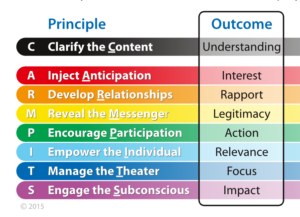I want you to go on stage and burp. Go on stage and scream. Go on stage and act like a clown. No, I’ve never said that, but based on the reaction I get, some people feel like I’m actually asking them to go on stage naked.
If you come to one of my classes or hire me as a coach, you’ll probably see me do all of those things. Yes, I have screamed. Yes, I have burped. Yes, I have acted like a clown. I’ve told bad jokes. I’ve offended people. I’ve worn silly costumes. I’ve done things that are inappropriate. Yes, sometimes my experiments fail.
But usually, they work!
When I’m teaching a principle to a client I try to think of a extreme, exaggerated example that will be impactful and memorable.

In real-life, most people don’t want to be as extreme as the exaggerated metaphors in my classes. My demonstrations often produce an almost immediate response:
But what if I don’t …
What if I don’t want to look like a clown?
What if I don’t want to be inappropriate?
What if I don’t know how to be funny?
What if I don’t have a lectern?
What if I don’t have time?
What if I’m on a video conference?
What if I’m on the phone?
What if it’s just one-on-one instead of a group?
What if I don’t want to?
What if I’m scared?
What if my audience is a different culture?
What if my boss has different expectations?
What if I don’t …
People love to play the “what-if” game.
Just last week I was telling my kids about a new family rule. Instantly, I was bombarded by dozens of what-if scenarios. They were incredibly creative in coming up with hypothetical exceptions to the rule. It’s almost as if my kids were trying to find a way to ignore the rule … nah, couldn’t be, my kids wouldn’t do that … would they?
Foundation in principle
The same thing happens when I coach very capable professionals on my 8 principles of public speaking.
Those people who accept that the underlying principles are fundamentally true, ask what-if questions because they honestly want to understand how to apply the principle in a specific, real-life situation.
Those people who are afraid to try something new, often ask what-if questions because they doubt the principle and want to think up an excuse NOT to try.
I’m working on the premise that the 8 principles in my communication and presentation skills system are fundamental principles.
 To learn more about the 8 principles, click here.
To learn more about the 8 principles, click here.
You don’t make an airplane fly by ignoring gravity, you make an airplane fly by understanding the principle of gravity better, and then applying the principle it to your specific solution.
What changes from one audience or situation to the next is not the principles. What changes is the specific application.
The Effectiveness Continuum
If you have ever been to one of my classes you’ll know that to explain some of those principles, I tell you do things like “keep secrets” or “use stereotypes” or “show personality” or “go negative” or “be dramatic” and so on.
Those directives can scare you if you’re imagining the extreme version of their application. Extreme versions of “stereotypes” and “drama” can seem wildly inappropriate. It doesn’t mean the principle is wrong, it just means the extreme application you are imagining might be inappropriate.
Use the most effective tactic that’s appropriate
There are innumerable ways to apply every principle. I can rank those speaker’s techniques from most effective to least effective on a simple scale divided into four approaches.
 Experience
Experience
The most effective approach is to provide real-life experience. When possible find a way for the audience to actually experience your message.
If you are talking about a roller coaster, the most effective approach to helping your audience understand is to actually take them on a REAL roller coaster ride.
If you are selling scented candles, the most effective tactics allow the audience to actually smell the real candles. If you want to prove to me that your product solves my problem, let me try your product and EXPERIENCE the solution.
If you really want the audience to understand the life of an injured veteran amputee, the most effective tactic would be to actually amputate the audience’s legs!
Effective yes, appropriate no.
Sometimes, real experience is impossible. Often, real experience is inappropriate. When impracticle move down the continuum to the next most effective tactic.
 Observation
Observation
If your audience can’t physically experience your topic, second best is OBSERVING the reality of someone else’s experience.
You can’t amputate audience member’s legs, but you can introduce them to an actual amputee who can show them a REAL example.
Ideally, you want to talk to, empower, compliment, validate, and interact with every individual member of your audience. In a large group, that’s impossible. Second best, you let the whole audience OBSERVE your interaction with selected members of the audience.
Ideally, when you’re applying for a job you want the interviewer to have already had real experience working with you. When she hasn’t, you want to bring examples and evidence the she can OBSERVE about how you have worked with others.
Ideally, you have experience together or at least examples they can observe. If you don’t, move down the continuum.
Imagination

Third most effective is helping the listener imagine your subject in their own minds. For the purpose of this scale, the only difference between “observation” and “imagination” is that imagination isn’t real.
If you are running for elected office and asking me for my vote, the incumbent has an advantage. Why? Because the incumbent has an observable past with the electorate. Barack Obama can show you REAL things he does as president, Donald Trump must ask you to IMAGINE what he would do.
When done correctly, imagination is incredible powerful.
If you’re pitching me on a new product idea or hypothetical future relationship, I can’t experience your product, and I can’t observe it–because it doesn’t exist yet. Lots of public speaking situations fall into the category of proposals, hypotheticals, and future unrealized plans. Help me imagine the benefits.
Fill in the unknowns in my imaginary world. Help me imagine how my peers will react. Ask me about my goals, objectives and dreams.
Place me in the hypothetical world that you want to create. Paint a picture of the possibilities and ask me to imagine the outcome.
 Explanation
Explanation
Unfortunately, very very few presenters do any of the above. The vast majority of speakers don’t even consider giving the audience a tangible experience. Most don’t even consider showing them someone else’s experience to observe. Only rarely do speakers use words that excite the listener’s imagination.
The vast majority of time, public speaker do nothing but explanation.
I hate to even include explanation on the “effectiveness continuum” because it’s NOT effective. Explanation is not the worst of the best options, it’s the best of the worst options.
Unfortunately, pure explanation is frequently necessary. You don’t need me to explain what an explanation is. You’ve been there, done that, and fallen asleep.
By the way, you might notice that my blog posts are nearly 100% explanation. That’s correct. Explanation is easy. The more effective approaches take more planning, more preparation, and more practice.
My blog is also WRITTEN COMMUNICATION. Written communication is never experiential and rarely something to observe. In a written medium you’re limited to mostly explanation and imagination. Explanation is not nearly as ineffective in a written medium as it is in a verbal medium. Please don’t confuse the style of a how-to blog, with the style of a video or speech.
Answering the Exceptions
 The answer to every what-if question is that you use the most effective tactic that is appropriate. If possible, create an EXPERIENCE. If you can’t use experience, use OBSERVATION. Otherwise, use IMAGINATION. Then and only then, settle for explanation. So let’s give it a try. Let’s answer the what-ifs:
The answer to every what-if question is that you use the most effective tactic that is appropriate. If possible, create an EXPERIENCE. If you can’t use experience, use OBSERVATION. Otherwise, use IMAGINATION. Then and only then, settle for explanation. So let’s give it a try. Let’s answer the what-ifs:
What if I’m on a video conference?
I get this one a lot. I coach people on how to use the stage, but so much of business communication now days happens on a screen. You can’t have a physical, tangible personal EXPERIENCE on a screen.
What about second best? Yes you CAN give them an experience to OBSERVE. You CAN prepare videos or visuals that can be shared online.
Third–but what if I don’t have time to prepare visuals? That’s okay. You CAN still ask them to IMAGINE the situation or place themselves in a hypothetical.
What if you’re on the phone or video? Apply the principles anyway.
What if I’m scared?
Often when meeting with a client they share embarrassing personal stories with me in a casual conversation. Not infrequently I tell them to share the same story on stage. This makes people uncomfortable. It’s scary to be vulnerable on stage.
I’m asking them to let the audience OBSERVE their personal story–because that would be the most effective option available.
If I can’t convince them to try and let the audience observe their REAL personality, we go to third best option and I ask them to give their audience a hypothetical situation. We help the audience IMAGINE an experience that conveys the same emotions.
What if I don’t want to be emotional?
Avoiding emotion is very common. I ask people all the time to infuse more passion, more enthusiasm, and more emotion–but emotion and drama is frowned upon in many business settings.
Best: Get the audience to EXPERIENCE the emotion of using your product.
Second: Let them OBSERVE someone else experiencing the emotion of using your product.
Neither of those are inappropriate in most business situations, yet most of us are afraid to try. I get it. Just reframe it. Instead of letting them see your emotion you can ask them to remember (i.e. OBSERVE) their own emotion in a similar situation.
Third: Ask them to IMAGINE the emotion of using your product.
Fourth: EXPLAIN IT–Tell them why your product will make them happy. GAG! Isn’t it obvious why you don’t want to settle for mere explanation?
We could go through more what-if questions, but I think you get the idea.
Yeah, but …
All of those things I’ve done on stage that made me look stupid taught me what works. You’ll never know it doesn’t work if you don’t try.
I tend to try the extreme experiment first just to see if it works, and then dial it back when I fail. That’s how I broke out of my introverted speaking anxiety shell. I’m not saying that you have to do it that way.
I’m not asking you to go all the way from staid explanation to clownish drama. Start wherever you are and try the next level up. If you’ve never tried more then explanation, move up to imagination. If you’re comfortable with observations, give experience a go.
If you trust the principles, don’t assume the attempt will fail, assume the attempt will win.
IMAGINE . . .
What if you help them EXPERIENCE?
What if you help them OBSERVE?
What if you help them IMAGINE?
What if you don’t have to EXPLAIN?
Don’t ask yourself what-if you don’t?
Ask yourself what if you DO?

